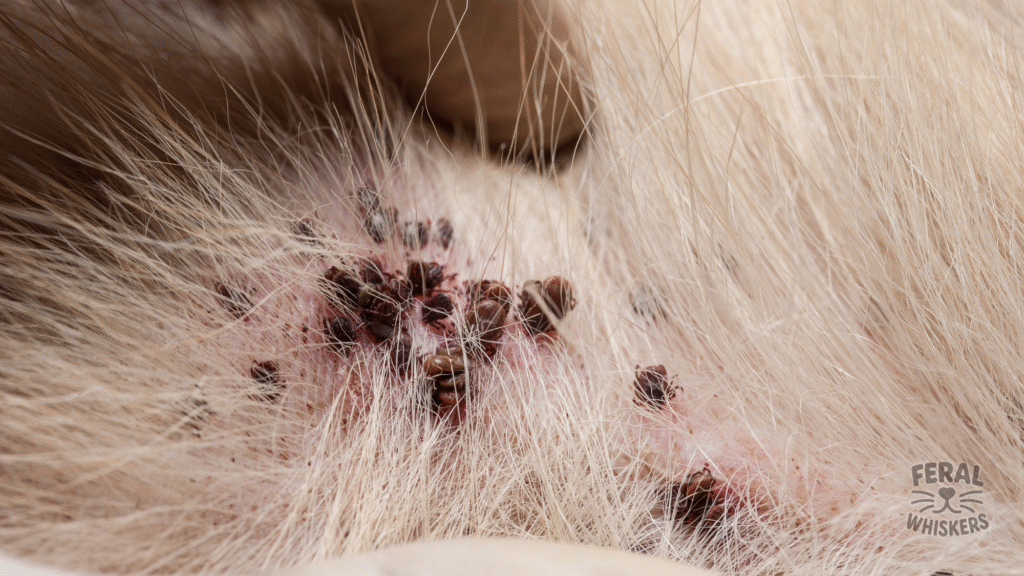Why RMSF Matters

Rocky Mountain Spotted Fever (RMSF) is one of the most serious tick‑borne diseases in dogs, caused by the bacterium Rickettsia rickettsii. Unlike Lyme disease, which mainly attacks the joints, RMSF primarily targets the cells lining small blood vessels — this leads to widespread inflammation, bleeding issues, and organ stress.
⚠️ What makes RMSF especially dangerous is how fast it progresses. A dog may seem fine one day, but within days can develop high fever, neurological problems, or life‑threatening bleeding.
It’s also a zoonotic concern — not because dogs pass it directly to humans, but because the same ticks that infect dogs also infect people. Protecting your pet protects your household.
How Dogs Get Rocky Mountain Spotted Fever
RMSF is carried by different species of ticks depending on region:
- American Dog Tick (Dermacentor variabilis) – common across the U.S.
- Rocky Mountain Wood Tick (Dermacentor andersoni) – western U.S.
- Brown Dog Tick (Rhipicephalus sanguineus) – found worldwide, especially in kennels and warmer regions.
Dogs become infected when:
- A tick feeds for several hours and passes Rickettsia bacteria into the bloodstream.
- Rarely, via blood transfusion from an infected donor.
Ticks are most active in spring and summer, but brown dog ticks can transmit year‑round indoors and in kennels.
Life Cycle of RMSF in Dogs
- Tick Bite & Transmission → tick injects saliva carrying Rickettsia.
- Bacteria Enter Blood Cells → they target endothelial cells (lining blood vessels).
- Blood Vessel Inflammation → causes swelling, leakage, bruising, and clotting issues.
- Organ Involvement → brain, kidneys, lungs, skin, and eyes can all be impacted.
- Immune Response & Recovery or Progression → some dogs clear the infection with treatment, others may progress to critical illness if untreated.
Symptoms of Rocky Mountain Spotted Fever in Dogs
RMSF symptoms usually appear 2–14 days after tick exposure. They can range from mild fever to severe organ failure.
Stage 1: Early RMSF (Acute Infection)
- High fever (103–105°F)
- Reduced appetite
- Depression / tiredness
- Joint and limb stiffness
- Swollen lymph nodes
👉 At this stage, RMSF looks very similar to other tick diseases (like Lyme or Ehrlichiosis).
Stage 2: Vascular Damage
- Bruising under the skin (petechiae)
- Spontaneous nosebleeds, bleeding gums
- Edema (swelling of face, legs, scrotum)
- Eye inflammation or bleeding in retinas
- Coughing, shortness of breath (if lungs affected)
👉 This stage is where RMSF becomes life‑threatening due to blood clotting and oxygen delivery issues.
Stage 3: Neurological / Severe RMSF
- Seizures
- Loss of coordination (ataxia)
- Muscle tremors
- Paralysis or collapse
- Coma in fatal cases
When to See a Vet 🩺
Don’t wait. RMSF can become deadly within days. Call your vet or emergency clinic if your dog shows:
- Fever with recent tick bite/exposure
- Sudden limping or stiffness
- Bruises or pinpoint red spots on skin
- Nosebleeds or gum bleeding
- Neurological changes (seizures, confusion, collapse)
Tip: Always mention tick history to your vet — it speeds up diagnosis.
Diagnosing RMSF
RMSF is tricky because early symptoms mimic many illnesses. Vets rely on a combination of:
- History & geography: tick exposure + living in/visiting an RMSF‑endemic area.
- Physical exam: fever, bruising, swollen lymph nodes.
- Blood tests (CBC): low platelets, anemia, liver/kidney abnormalities.
- Antibody test (IFA/EIA): looks at immune response (may lag in early stage).
- PCR testing: detects the DNA of the bacteria.
🔑 In practice: most vets don’t wait for final results — they start doxycycline immediately if RMSF is suspected, because delay can be deadly.
Veterinary Treatment
Antibiotics
- Doxycycline is the gold standard.
- Typical course: 2–3 weeks minimum.
- Dogs often improve dramatically within 24–48 hours of starting treatment.
Supportive Care
- IV fluids (for dehydration & supporting blood pressure).
- Pain relief for stiff muscles/joints.
- Hospital monitoring if neurological symptoms or bleeding are severe.
- Blood transfusions in dogs with critical anemia.
Holistic Support 🌿
Holistic support is about strengthening the body’s recovery, reducing inflammation, and protecting organs under stress.
🥣 Healing Recovery Diet
Focus on foods that protect blood vessels and replenish nutrients lost from infection.
- Protein for healing: turkey, salmon, chicken, eggs.
- Iron sources (for anemia): lean beef, cooked liver (moderation 1x a week).
- Antioxidants: blueberries, carrots, spinach → protect vessels.
- Hydration boosters: bone broth, pumpkin, cucumber.
- Anti‑inflammatory fats: fish oil or sardines.
👉 Circulatory Healing Recipe
- 1 cup turkey (boiled & shredded)
- ½ cup sweet potato (antioxidants + energy)
- ¼ cup steamed spinach & carrots
- 2 tbsp bone broth
- 1 tsp fish oil (after cooling)
Serve warm 2–3× weekly alongside balanced vet‑approved diet.
🌿 Herbal & Supplement Support
- Milk thistle → liver helper (detox).
- Dandelion root → kidney protection.
- Turmeric + black pepper → natural anti‑inflammatory.
- CoQ10 & Vitamin E → support heart and blood vessels.
- Astragalus & medicinal mushrooms (reishi, cordyceps) → immune strength.
- Probiotics → restore gut balance during/after antibiotics.
Prevention
🚫 No vaccine for RMSF. Prevention is entirely about tick control and lifestyle.
✅ Veterinary Prevention
- Monthly tick preventatives (chewables like NexGard, Simparica, Bravecto).
- Tick collars or spot‑ons.
- Year‑round in warmer climates.
✅ Home & Environment Prevention
- Tick checks daily, esp. ears, armpits, toes, groin.
- Keep grass trimmed, yard debris cleared.
- Wash bedding frequently.
- Treat kennels with tick‑safe sprays.
✅ Holistic Prevention Add‑Ons
- Apple cider vinegar rinse (dilute with water, spritz coat before walks).
- Neem oil spray (high dilution → mix with carrier oil).
- Herbal collars (cedar oil, rosemary).
- Add immune‑boosting foods (blueberries, pumpkin, sardines).
💡 Natural methods are supportive only → always pair with vet‑approved tick preventatives.
Long‑Term Outlook
- Quick treatment = excellent prognosis.
- Most dogs recover fully with no lasting issues.
- Delayed treatment = dangerous. Severe cases may cause:
- Ongoing neurological damage.
- Chronic vascular issues.
- Organ damage (kidneys, liver).
Human Risk
Rickettsia rickettsii also causes RMSF in humans. While dogs don’t directly infect humans, the shared ticks pose the threat.
Protect entire household by:
- Using dog tick preventatives.
- Checking humans after walks/hikes.
- Wearing tick‑repellent treated clothing outdoors.
Facts
- RMSF isn’t limited to the Rocky Mountains — cases are common in the Midwest, Southeast, and even Mexico/Central America.
- First described in 1900 as “black measles” in humans due to skin spots.
- Dogs can act as sentinels — outbreaks in pets often signal human risks in the same area.
FAQs
How is RMSF different from Lyme disease?
Lyme causes joint disease and kidney issues; RMSF damages blood vessels, leading to bleeding, swelling, and organ involvement.
Does every tick bite = RMSF?
No. Only infected ticks transmit R. rickettsii. But always monitor after bites.
How fast should treatment start?
Immediately. Waiting for confirmation tests can risk death.
Can dogs relapse?
True relapses are rare if antibiotics are completed. Chronic damage comes from delayed treatment.
Is RMSF fatal?
Yes, if untreated. Mortality can reach 20–30% in severe canine cases, especially with neurologic signs.
Final Takeaway
Rocky Mountain Spotted Fever is one of the deadliest tick-borne diseases in dogs. It can cause fever, swelling, bleeding, and brain involvement if untreated.
But with fast doxycycline treatment, most dogs recover fully. Holistic approaches — immune diets, liver/kidney herbs, and antioxidant foods — help speed recovery and protect against organ damage.
Since no vaccine exists, tick prevention is the only proven shield — keep your pup (and family) protected year‑round.

